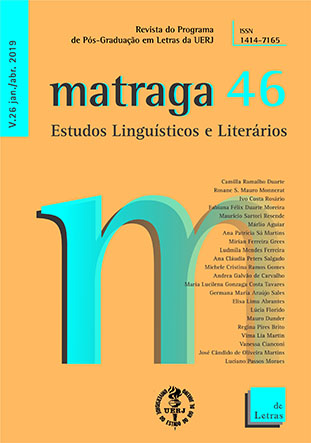Uses of the conector ‘except’: a panorama under the perspective of usage-based functional linguistics
DOI:
https://doi.org/10.12957/matraga.2019.32050Keywords:
Hypotaxis. Exception. Except.Abstract
The objective of this work is to outline the uses of the connector except (and compound forms - except that, except if, except when), its main morphosyntactic features and semantic values. The analysis of the subject takes place in the perspective of Usage- Based Functional Linguistics, adopting the theoretical assumptions of CROFT (2001), GOLDBERG (1995, 2006), GOLDERG; CASENHISER (2010), KORTMANN (1997) and TROUSDALE (2008). Based on a real language corpus of Brazilian Portuguese, we attested seven different patterns for the exception construction instantiated by the connector except: three non-clausal patterns (except + NP, except + preposition and except + adverbial) and four clausal patterns (except + when, except + if, except + that and except + infinitive). Based on these statements, we postulate the existence and productivity of constructions of exception in Brazilian Portuguese.
Downloads
Downloads
Published
How to Cite
Issue
Section
License
Authorization
Matraga – Scientific Journal of the Post-graduate Program in Arts and Humanities of UERJ is authorized to publish the article submitted here, if it is accepted for online publication. It is attested that the contribution is original, that it is not being submitted to another publisher for publication, and that this statement is the expression of truth.
The works published in Matraga's virtual space – Scientific Journal of the Post-graduate Program in Arts and Humanities of UERJ will be automatically transferred, and your copyright is reserved to Matraga. Its reproduction, in whole or in part, is conditional on the citation of the authors and the data of the publication.

Matraga uses license Creative Commons - Attribution-Non-Commercial 4.0 International.





